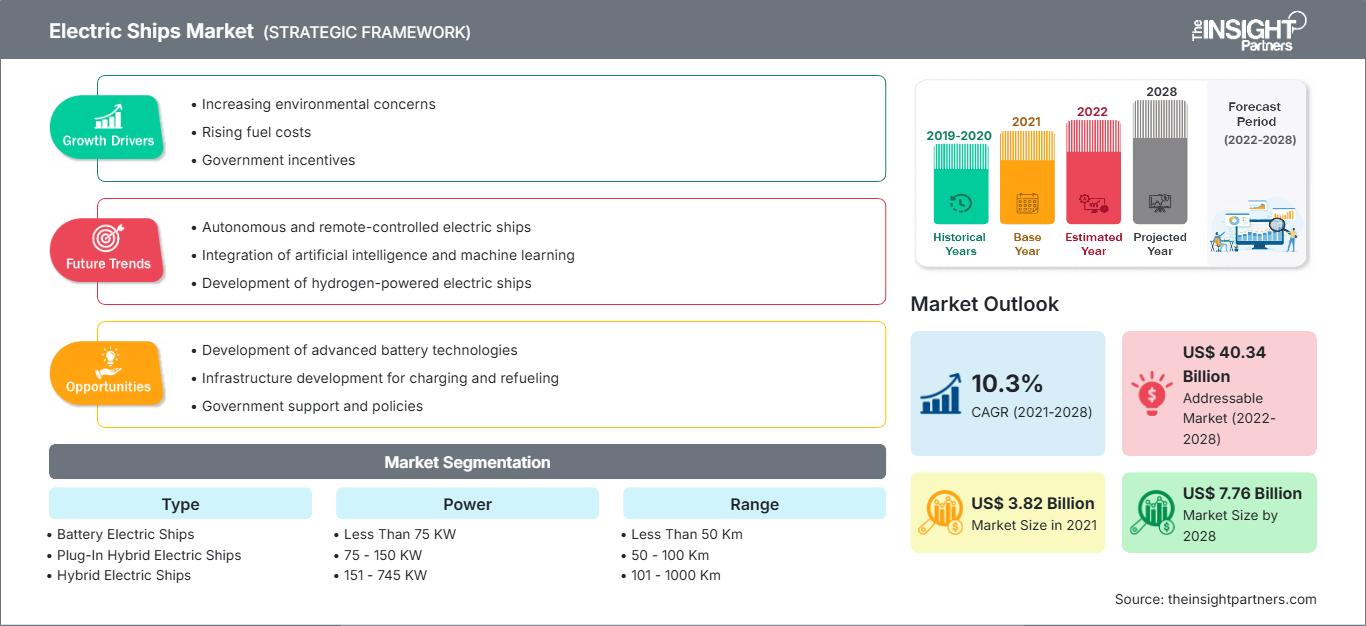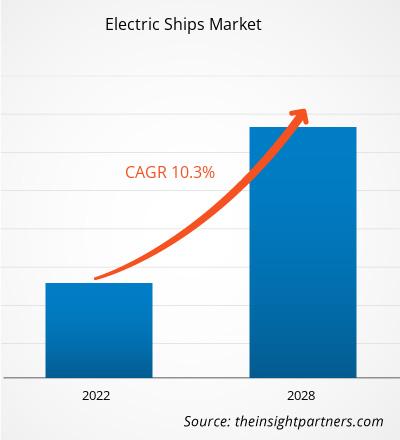2021 年电动船舶市场价值为 38.2 亿美元,预计 2021 年至 2028 年的复合年增长率为 10.3%。
电动船是指任何以电力驱动系统为主要推进技术的船舶。它可以是全电池电动、氢燃料电池电动或电动混合动力船舶,包括拖船、渡轮、货船、驳船、游船、拖网渔船、游艇和无人水下航行器 (UUV)。与传统的柴油发动机船舶不同,电动船是电力驱动的。这些船舶使用电池存储装置作为电源来驱动电动机。电动船可以使用多种类型的电池,包括锂离子电池、铅酸电池和燃料电池。电动船主要是内河航行的渡轮和小型客船,完全依靠电力航行。它们一次充电只能行驶约80公里的短距离。此外,太阳能船舶也用于需要低功率输出的轻型船舶。然而,由于货船重量较大,纯电动系统无法满足其电力需求;因此,货船正在使用柴油-电力混合动力系统。
自定义此报告以满足您的要求
您将免费获得任何报告的定制,包括本报告的部分内容,或国家级分析、Excel 数据包,以及为初创企业和大学提供超值优惠和折扣
电动船舶市场: 战略洞察

- 获取本报告的主要市场趋势。这个免费样本将包括数据分析,从市场趋势到估计和预测。
您将免费获得任何报告的定制,包括本报告的部分内容,或国家级分析、Excel 数据包,以及为初创企业和大学提供超值优惠和折扣
电动船舶市场: 战略洞察

- 获取本报告的主要市场趋势。这个免费样本将包括数据分析,从市场趋势到估计和预测。
新冠疫情对电动船舶市场的影响
新冠疫情对电动船舶市场产生了不利影响。这场疫情对全球人类流动造成了前所未有的冲击。在海洋中,由于对人类活动的严格限制和商品消费的变化,船舶活动受到影响。由于新冠疫情,一些国家关闭了邮轮业。然而,一些邮轮公司正试图在疫情期间恢复运营。新冠疫情彻底改变了人类的海洋活动,据报道,港口限制和消费模式的转变影响了多个海事部门、渔业、客运渡轮和邮轮。然而,在某些地区,货物运输在封锁期间被宣布为必不可少的,这为电动船舶市场创造了一个有利可图的机会。
电动船舶市场洞察
混合动力和电力推进系统在船舶改装中的应用日益增多
船舶改装正日益受到人们的关注,并吸引着船东/造船商延长其现有船舶的使用寿命。这种过程提供了一个降低燃料消耗、并作为一种经济有效的程序随时了解最新环保解决方案的机会。改装正在成为海运业的一种普遍做法。造船商正在朝着自动化、集成新建船舶以及为现有船舶改装混合动力和电力推进系统的方向发展。该系统是改造老旧船舶的便捷选择,具有巨大的改造潜力,包括渡轮、集装箱船、游轮、拖船和普通货船。造船厂选择为船舶改装混合动力电力推进系统或全电力推进系统,因为这比购买新船相对便宜。此外,一些欧洲造船厂正在积极为其现有船队改装混合动力和电力推进系统。例如,根据 Riviera Maritime Media Ltd 发表的文章,2020 年 3 月,近海供应船 (OSV) 船东投资为柴电/液化天然气 (LNG) 动力船队改装电池混合动力推进系统,此举为租船人、船东以及挪威的环境问题带来了回报。这些因素促使人们采用混合动力和电力推进系统来改装船舶。
基于类型的市场洞察
根据类型,电动船舶市场细分为电池电动船舶、插电式混合动力船舶和混合动力船舶。 2020年,混合动力电动船舶市场引领市场。混合动力电动船舶凭借其可靠性和更高的航速,支撑了其市场需求,这得益于其辅助推进系统和更高的航速,从而降低了故障风险,并在更短的时间内航行更远的距离。此外,混合动力电动船舶推进系统有两种推进方式——电力推进(柴电或电池驱动)和机械推进(柴油直接驱动)。此外,全球船东或航运物流公司都青睐混合动力电动船舶,因为它们可以降低油耗并有助于降低运营成本。在低功率情况下使用柴电推进系统,在需要高功率、以不同速度航行于内河时使用柴油直接驱动系统,可以降低电动船舶的运营成本。这是一种更智能地利用可用能源并节省燃料成本的方法,即使用混合动力电动船舶推进系统。电动船舶市场的参与者采取并购和市场举措等策略来保持其市场地位。以下列出了一些主要参与者的进展。
- 2021年11月,BAE系统公司推出了新一代电力和推进系统,以帮助船舶运营商实现零排放。该系统提供了一种灵活的解决方案,可以提高电气效率和船舶续航里程,增加推进功率并简化安装。
- 2020年9月,Kolumbus(一家移动出行公司)和Fjellstrand(一家造船厂)签署了一份合同,将交付世界上第一艘全电动快速渡轮。该项目获得了欧盟“地平线2020”研究与创新计划的资助。
根据类型,电动船舶市场细分为电池电动船舶、插电式混合动力船舶和混合动力船舶。根据功率,电动船舶市场细分为小于75千瓦、75-150千瓦、151-745千瓦、746-7560千瓦和大于7560千瓦。根据续航里程,电动船舶市场细分为小于50公里、50-100公里、101-1000公里和大于1000公里。根据船舶类型,电动船舶市场细分为邮轮、渡轮、油轮、散货船、渔船、驱逐舰、航空母舰和其他。根据地域,电动船舶市场细分为五大区域——北美、欧洲、亚太地区 (APAC)、中东和非洲 (MEA) 和南美 (SAM)。
电动船舶市场
The Insight Partners 的分析师已详尽阐述了预测期内影响电动船舶市场的区域趋势和因素。本节还讨论了北美、欧洲、亚太地区、中东和非洲以及南美和中美洲的电动船舶市场细分和地域分布。
电动船舶市场报告范围
| 报告属性 | 细节 |
|---|---|
| 市场规模 2021 | US$ 3.82 Billion |
| 市场规模 2028 | US$ 7.76 Billion |
| 全球复合年增长率 (2021 - 2028) | 10.3% |
| 历史数据 | 2019-2020 |
| 预测期 | 2022-2028 |
| 涵盖的领域 |
By 类型
|
| 覆盖地区和国家 | 北美
|
| 市场领导者和主要公司简介 |
|
电动船舶市场参与者密度:了解其对商业动态的影响
电动船舶市场正在快速增长,这得益于终端用户需求的不断增长,而这些需求的驱动因素包括消费者偏好的不断变化、技术进步以及对产品优势的认知度不断提高。随着需求的增长,企业正在扩展产品线,不断创新以满足消费者需求,并抓住新兴趋势,从而进一步推动市场增长。

- 获取 电动船舶市场 主要参与者概述
公司简介
- BAE 系统公司
- 达菲电船公司
- Fjellstrand AS
- X Shore
- 通用动力电船公司
- Hurtigruten
- MAN 能源解决方案公司
- PortLiner
- 西门子能源公司
- VARD AS
- 历史分析(2 年)、基准年、预测(7 年)及复合年增长率
- PEST和SWOT分析
- 市场规模、价值/数量 - 全球、区域、国家
- 行业和竞争格局
- Excel 数据集
近期报告
客户评价
购买理由
- 明智的决策
- 了解市场动态
- 竞争分析
- 客户洞察
- 市场预测
- 风险规避
- 战略规划
- 投资论证
- 识别新兴市场
- 优化营销策略
- 提升运营效率
- 顺应监管趋势




















 获取免费样品 - 电动船舶市场
获取免费样品 - 电动船舶市场